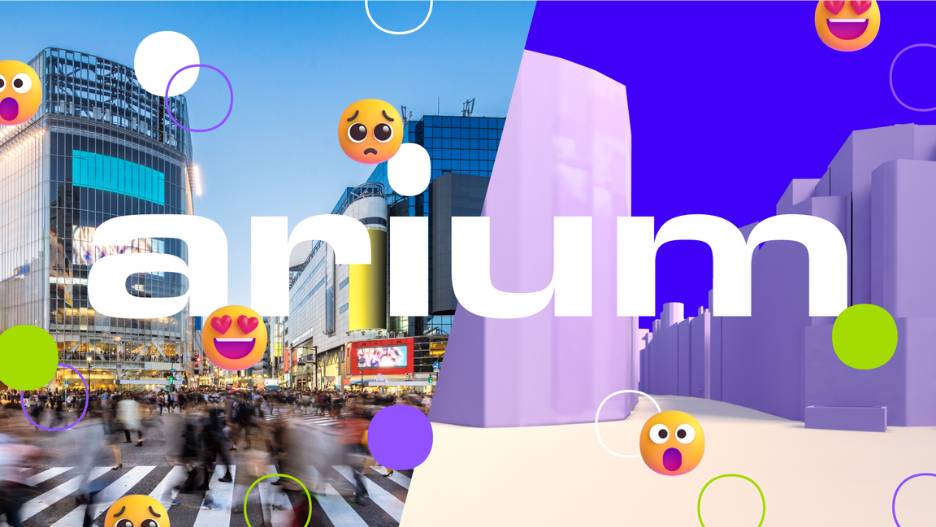- City & Transport
arium
- Ministry of Land, Infrastructure, Transport, and Tourism
- Hakuhodo DY Holdings

About
As part of the nationwide 3D city model development and open data project "PLATEAU" promoted by the Ministry of Land, Infrastructure, Transport, and Tourism, we developed the AR and metaverse integration platform "arium" where users and businesses can interact and experience in both directions. We conducted the proof-of-concept experiment of this project in collaboration with Hakuhodo DY Holdings.
Background
Recently, the term "metaverse" has gained attention in the global market, and the VR/AR device market and related content market have grown significantly. With people's activities and interactions expanding into XR and metaverse spaces, MESON envisions a future where the foundation of communication spaces and entertainment expands into XR and metaverse spaces.
Currently, the physical urban space, once perceived as tangible, is extended into the cyber world by XR technology, allowing access from different locations and time axes. We believe that the scale of city activities will be measured not only by the number of residents and visitors but also by the number of accesses via online channels. Envisioning the importance of AR and metaverse urban spaces where everyone can participate and interact beyond physical distances and time constraints, we developed arium.
Based on this context, arium was launched as a media-crossing project that allows experiences spanning both urban AR and metaverse spaces.
By linking the "urban AR experience," where virtual content can be placed in existing urban spaces, and the "metaverse space experience," which replicates the corresponding urban space, we aimed to seamlessly integrate urban AR and metaverse experiences.
Execution
We developed "arium," a communication app where users can play with 3D content in existing cities and virtual urban spaces recreated using 3D content. By posting 3D content, users can enjoy playful communication and connect with friends and family.
There are two ways to enjoy arium:
(1) Mobile AR App: Take a look at the city scenery you enjoy by walking around or shopping through the app's camera. 3D content placed by other users is scattered throughout the city. It varies from messages to someone, brightening up the city with monuments, and more. Leave reactions or comments at any time to enjoy communication through 3D content.
(2) PC Metaverse Site: If you don't have time to visit or are not close enough to play, access the virtual urban space modeled after the actual urban space from your PC. The locations where 3D content is placed are also in the same position in the virtual city. Even if you have friends or family who live far away and can't meet in the real world, by using arium, you can feel a connection as if you are experiencing the same things in the city together.
Results
In the proof-of-concept experiment, MESON and Hakuhodo DY Holdings jointly examined the verification hypotheses and verified the performance of the CMS/app as well as the usefulness for assumed business operators and end-users. As a result, it was confirmed that content placement and display could be achieved with an accuracy of about 1 meter, and various use cases were verified, such as displaying characters and artworks in accordance with the shapes of buildings in the city space and pinpointing information about the city, such as stores and tourist spots. It was confirmed that the CMS and AR app could be operated with sufficient accuracy. For details of the experimental results, please refer to the following website of the Ministry of Land, Infrastructure, Transport and Tourism:
MLIT Plateau Use Case.
In the future, arium will continue to improve the platform's value and develop functionalities through collaboration with location owners and content holders. Arium will also promote IP content utilization and information content presentation in urban spaces, which received a lot of utilization intentions from businesses in the proof-of-concept experiment.
For users visiting various cities in Japan, placing 3D content of characters from anime and manga in the city can create new urban exploration experiences and communication touchpoints between brands and fans. It could also be new appealing content for inbound tourists. In addition, in promotional use cases at stores and commercial facilities, we believe that we can expand sales promotion activities such as distributing information about products and coupons and selling digital products such as NFTs on arium.
We will continue to hold events gathering end-users as public initiatives to continuously improve the product. Although this proof-of-concept experiment targeted the Shibuya area, as 3D city models of PLATEAU are available in other cities, we will expand the application areas according to the events and initiatives. Furthermore, by utilizing the technology of "GIBSON" developed in the Project PLATEAU's private sector use case development "Cyber-Physical Cross-Communication in Urban Spaces with AR/VR" in the fiscal year 2020, we will advance the development of immersive experiences particularly suitable for entertainment and tourism use cases with high affinity. While exploring methods to construct more immersive virtual spaces using 3D city models, we aim to expand the penetration of XR experiences nationwide and make XR experiences more accessible to everyone.
Credit
- Service Planning & Design and Development
- Kent Kajitani, Seiichiro Takeuchi, Kohei Endo, Kazuya Hiruma, Mathilda, Shuto Umemura, Shogo Ajina, Masaki Morihara, Chika Fujimoto,Nobuyuki Furukawa